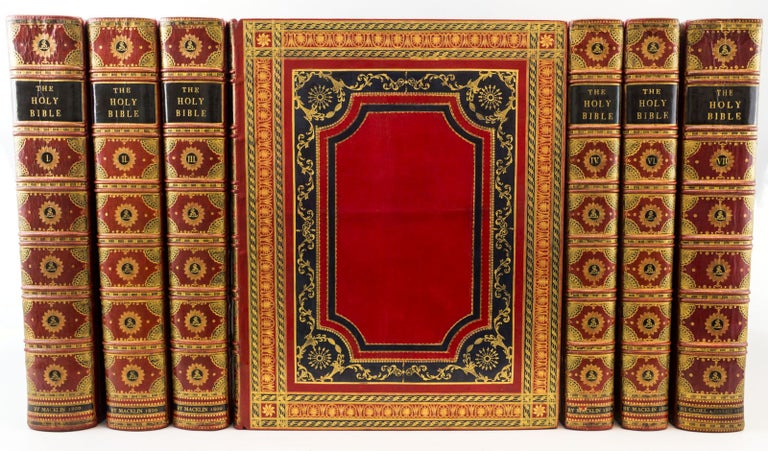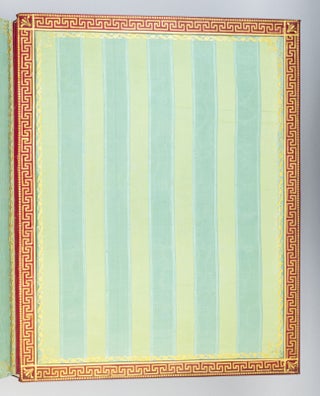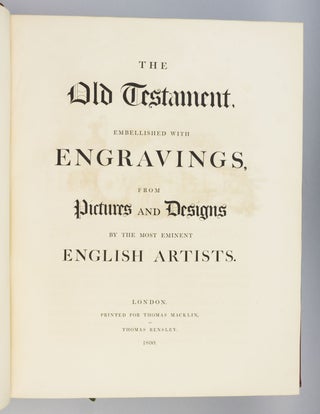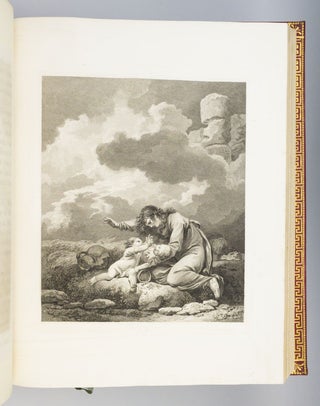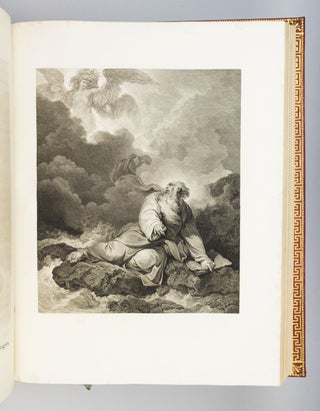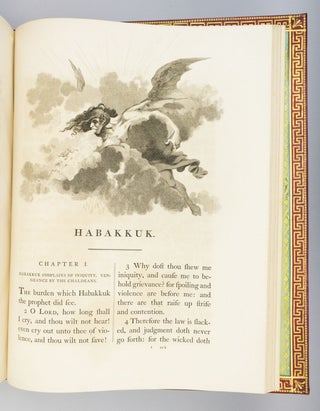(THE MACKLIN BIBLE).
(London: T. Bensley for T. Macklin [final volume Bensley for T. Cadell & W. Davies], 1800 [for the six volumes of the Bible], 1816 [for the Apocrypha]). 480 x 385 mm. (19 x 15 1/8"). One leaf in the Apocrypha (3P2, comprising two prologues of Ecclesiasticus) invisibly inserted from another copy. Seven volumes (comprising the regular Bible in six volumes, and the Apocrypha, usually not included, as a seventh volume). First Printing of this Edition.
ABSOLUTELY MAGNIFICENT CONTEMPORARY RED NEOCLASSICAL-STYLE STRAIGHT-GRAIN MOROCCO, SUMPTUOUSLY GILT AND ONLAID WITH BLUE, BY GEORG FRIEDRICH KRAUSS, done for Prince Albert Casimir, Duke of Saxe-Teschen (with repeated "AST" monogram), covers with very elaborate frames incorporating 11 plain and decorative gilt rules, four onlaid borders of blue morocco, and very elegant swirling foliate ornamentation around the central scalloped panel, six pairs of raised bands, each pair flanking a recessed gilt and blue metope and pentaglyph rule, very handsome spine compartments with blue fan-shaped cornerpieces and central gilt-decorated blue medallions within sunburst gilt collars, turn-ins with Greek key pattern in gilt, striking endleaves of turquoise and green watered silk (the Apochrypha endleaves slightly different). With more than 100 allegorical headpieces and tailpieces and some 70 SPLENDID LARGE-FOLIO-SIZE COPPER PLATES after Fuseli, Reynolds, West, and others, most plates printed before letters. Tissue guards (perhaps later). Herbert 1442 and 1651. ◆First volume with about 30 leaves noticeably foxed, the majority of plates offset onto previous and following pages, consistent inoffensive offsetting of text on facing pages, other trivial imperfections, but still a very impressive copy internally, with the luxurious paper used for the text both fresh and clean, and the engravings richly impressed and with very little foxing. Some unimportant scuffing and rubbing to the leather, but all defects minor, THE MAGNIFICENT BINDINGS REMARKABLY WELL PRESERVED, the heavy volumes completely solid, with only insignificant signs of use, and THE MOROCCO AND LAVISHLY GILT DECORATION EXTREMELY BRIGHT. AN ALTOGETHER MEMORABLE COPY.
The most prodigious form of Scripture in English ever published, the Macklin Bible was often put into ornate bindings, especially by London binders like Staggemeier and his contemporaries. But, however much other sets may glisten, the present magnificent example surely stands at or near the front of the line as one of the most lavishly decorated and arresting copies in existence. Its decorative extravagance also testifies to the fact that Macklin's publication was sufficiently admired outside of England to warrant the finest workmanship and the expenditure of great sums of money on artistic resources. The very large and bold type, the fine Whatman paper, and the series of engravings by some of the most celebrated artists of the period make this an item that is already very desirable. Like the Boydell "Shakespeare Gallery" (also printed by Bensley), our Macklin Bible is a vast picture book with illustrations that are grand both in size and emotional impact. But it is, of course, the bindings here that matter the most. Francesco Piranesi is generally given credit for inventing the Neoclassical style when he designed volumes presented to Gustavus III of Sweden during this monarch's visit to Rome in 1783-84. Quickly popular, the Neoclassical style was imitated and developed by Staggemeier & Welcher in London, by F. W. Standlander in Stockholm, and by Georg Friedrich Krauss in Vienna. Krauss was the most prominent Continental binder working in this style of the day, and Saxe-Teschen was perhaps his most important client. Products of the Krauss bindery have passed through some of the most distinguished collections over the years, particularly those of Fürstenberg and Schäfer; and his bindings have consistently brought remarkable sums of money at auction. It is sufficient to say that the present group of bindings represents the most impressive collection of decorative volumes we have ever offered for sale. The collector for whom these bindings were originally executed, Duke Albert of Saxe-Teschen (1738-1822), was the son of Friedrich August II of Saxony and the son-in-law of the empress Maria Theresa. After providing important military and civil service to the Habsburg empire, he retired to Vienna in 1795 and afterward devoted himself to the fine arts. He founded the Albertina, which now houses the greatest collection of prints in the world, and he put together a great library distinguished by the highest taste and most exacting standards. The present copy has the additional distinction of containing what amounts to an extra volume: the Macklin Bible, however it is bound, most often appears in the marketplace without the Apocrypha, appearing here as Volume VII, which was not issued until 16 years after the others. It is also of some interest that the bindings of our seven volumes were decorated in an entirely uniform fashion (as a close inspection shows), something not typical of a set with volumes published so many years apart. (The non-uniform endleaves in the final volume here may have resulted from the fact that, given the physical size of the books, the binder simply ran out of the cloth he had used for lining the first six volumes.). (CJI1704)
Price: $85,000.00

